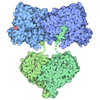+ Open data
Open data
- Basic information
Basic information
| Entry | Database: PDB / ID: 1miu | ||||||
|---|---|---|---|---|---|---|---|
| Title | Structure of a BRCA2-DSS1 complex | ||||||
 Components Components |
| ||||||
 Keywords Keywords | GENE REGULATION/ANTITUMOR PROTEIN / TUMOR SUPPRESSOR / BREAST CANCER SUSCEPTIBILITY / DNA-BINDING / GENE REGULATION-ANTITUMOR PROTEIN COMPLEX | ||||||
| Function / homology |  Function and homology information Function and homology informationHDR through MMEJ (alt-NHEJ) / Presynaptic phase of homologous DNA pairing and strand exchange / Homologous DNA Pairing and Strand Exchange / Resolution of D-loop Structures through Holliday Junction Intermediates / BRCA2-MAGE-D1 complex / HDR through Homologous Recombination (HRR) / negative regulation of mammary gland epithelial cell proliferation / establishment of protein localization to telomere / mitotic recombination-dependent replication fork processing / chordate embryonic development ...HDR through MMEJ (alt-NHEJ) / Presynaptic phase of homologous DNA pairing and strand exchange / Homologous DNA Pairing and Strand Exchange / Resolution of D-loop Structures through Holliday Junction Intermediates / BRCA2-MAGE-D1 complex / HDR through Homologous Recombination (HRR) / negative regulation of mammary gland epithelial cell proliferation / establishment of protein localization to telomere / mitotic recombination-dependent replication fork processing / chordate embryonic development / nuclear ubiquitin ligase complex / Impaired BRCA2 translocation to the nucleus / Impaired BRCA2 binding to SEM1 (DSS1) / histone H4 acetyltransferase activity / histone H3 acetyltransferase activity / integrator complex / lateral element / regulation of DNA damage checkpoint / telomere maintenance via recombination / gamma-tubulin binding / proteasome regulatory particle, lid subcomplex / DNA repair complex / response to UV-C / oocyte maturation / Regulation of ornithine decarboxylase (ODC) / Proteasome assembly / Cross-presentation of soluble exogenous antigens (endosomes) / Homologous DNA Pairing and Strand Exchange / Defective homologous recombination repair (HRR) due to BRCA1 loss of function / Defective HDR through Homologous Recombination Repair (HRR) due to PALB2 loss of BRCA1 binding function / Defective HDR through Homologous Recombination Repair (HRR) due to PALB2 loss of BRCA2/RAD51/RAD51C binding function / Resolution of D-loop Structures through Synthesis-Dependent Strand Annealing (SDSA) / inner cell mass cell proliferation / Somitogenesis / Resolution of D-loop Structures through Holliday Junction Intermediates / female gonad development / hematopoietic stem cell proliferation / Impaired BRCA2 binding to RAD51 / replication fork processing / male meiosis I / hemopoiesis / centrosome duplication / Presynaptic phase of homologous DNA pairing and strand exchange / intrinsic apoptotic signaling pathway in response to DNA damage by p53 class mediator / response to X-ray / chromosome organization / proteasome assembly / mRNA export from nucleus / positive regulation of mitotic cell cycle / proteasome complex / secretory granule / stem cell proliferation / Regulation of activated PAK-2p34 by proteasome mediated degradation / response to gamma radiation / regulation of cytokinesis / cellular response to ionizing radiation / Autodegradation of Cdh1 by Cdh1:APC/C / APC/C:Cdc20 mediated degradation of Securin / Asymmetric localization of PCP proteins / Ubiquitin-dependent degradation of Cyclin D / SCF-beta-TrCP mediated degradation of Emi1 / NIK-->noncanonical NF-kB signaling / nucleotide-excision repair / TNFR2 non-canonical NF-kB pathway / AUF1 (hnRNP D0) binds and destabilizes mRNA / DNA damage response, signal transduction by p53 class mediator / Vpu mediated degradation of CD4 / Assembly of the pre-replicative complex / Ubiquitin-Mediated Degradation of Phosphorylated Cdc25A / Degradation of DVL / Dectin-1 mediated noncanonical NF-kB signaling / Cdc20:Phospho-APC/C mediated degradation of Cyclin A / Degradation of AXIN / Hh mutants are degraded by ERAD / Activation of NF-kappaB in B cells / Degradation of GLI1 by the proteasome / G2/M Checkpoints / Hedgehog ligand biogenesis / Defective CFTR causes cystic fibrosis / Autodegradation of the E3 ubiquitin ligase COP1 / GSK3B and BTRC:CUL1-mediated-degradation of NFE2L2 / Regulation of RUNX3 expression and activity / Negative regulation of NOTCH4 signaling / Hedgehog 'on' state / double-strand break repair via homologous recombination / Vif-mediated degradation of APOBEC3G / APC/C:Cdh1 mediated degradation of Cdc20 and other APC/C:Cdh1 targeted proteins in late mitosis/early G1 / FBXL7 down-regulates AURKA during mitotic entry and in early mitosis / Degradation of GLI2 by the proteasome / GLI3 is processed to GLI3R by the proteasome / MAPK6/MAPK4 signaling / brain development / Degradation of beta-catenin by the destruction complex / Oxygen-dependent proline hydroxylation of Hypoxia-inducible Factor Alpha / ABC-family proteins mediated transport / HDR through Homologous Recombination (HRR) / CDK-mediated phosphorylation and removal of Cdc6 / CLEC7A (Dectin-1) signaling / SCF(Skp2)-mediated degradation of p27/p21 / FCERI mediated NF-kB activation Similarity search - Function | ||||||
| Biological species |  Homo sapiens (human) Homo sapiens (human) | ||||||
| Method |  X-RAY DIFFRACTION / X-RAY DIFFRACTION /  SYNCHROTRON / SYNCHROTRON /  MAD / Resolution: 3.1 Å MAD / Resolution: 3.1 Å | ||||||
 Authors Authors | Yang, H. / Jeffrey, P.D. / Miller, J. / Kinnucan, E. / Sun, Y. / Thoma, N.H. / Zheng, N. / Chen, P.L. / Lee, W.H. / Pavletich, N.P. | ||||||
 Citation Citation |  Journal: Science / Year: 2002 Journal: Science / Year: 2002Title: BRCA2 function in DNA binding and recombination from a BRCA2-DSS1-ssDNA structure Authors: Yang, H. / Jeffrey, P.D. / Miller, J. / Kinnucan, E. / Sun, Y. / Thoma, N.H. / Zheng, N. / Chen, P.L. / Lee, W.H. / Pavletich, N.P. | ||||||
| History |
|
- Structure visualization
Structure visualization
| Structure viewer | Molecule:  Molmil Molmil Jmol/JSmol Jmol/JSmol |
|---|
- Downloads & links
Downloads & links
- Download
Download
| PDBx/mmCIF format |  1miu.cif.gz 1miu.cif.gz | 159.7 KB | Display |  PDBx/mmCIF format PDBx/mmCIF format |
|---|---|---|---|---|
| PDB format |  pdb1miu.ent.gz pdb1miu.ent.gz | 121.8 KB | Display |  PDB format PDB format |
| PDBx/mmJSON format |  1miu.json.gz 1miu.json.gz | Tree view |  PDBx/mmJSON format PDBx/mmJSON format | |
| Others |  Other downloads Other downloads |
-Validation report
| Summary document |  1miu_validation.pdf.gz 1miu_validation.pdf.gz | 384.5 KB | Display |  wwPDB validaton report wwPDB validaton report |
|---|---|---|---|---|
| Full document |  1miu_full_validation.pdf.gz 1miu_full_validation.pdf.gz | 457.2 KB | Display | |
| Data in XML |  1miu_validation.xml.gz 1miu_validation.xml.gz | 24.6 KB | Display | |
| Data in CIF |  1miu_validation.cif.gz 1miu_validation.cif.gz | 35.9 KB | Display | |
| Arichive directory |  https://data.pdbj.org/pub/pdb/validation_reports/mi/1miu https://data.pdbj.org/pub/pdb/validation_reports/mi/1miu ftp://data.pdbj.org/pub/pdb/validation_reports/mi/1miu ftp://data.pdbj.org/pub/pdb/validation_reports/mi/1miu | HTTPS FTP |
-Related structure data
- Links
Links
- Assembly
Assembly
| Deposited unit | 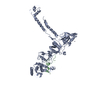
| ||||||||
|---|---|---|---|---|---|---|---|---|---|
| 1 |
| ||||||||
| 2 | 
| ||||||||
| Unit cell |
|
- Components
Components
| #1: Protein | Mass: 8284.611 Da / Num. of mol.: 1 Source method: isolated from a genetically manipulated source Source: (gene. exp.)  Homo sapiens (human) / Production host: Homo sapiens (human) / Production host:  |
|---|---|
| #2: Protein | Mass: 83350.562 Da / Num. of mol.: 1 / Fragment: Residues 2378-3115 Source method: isolated from a genetically manipulated source Source: (gene. exp.)   |
| #3: Chemical | ChemComp-HG / |
-Experimental details
-Experiment
| Experiment | Method:  X-RAY DIFFRACTION / Number of used crystals: 1 X-RAY DIFFRACTION / Number of used crystals: 1 |
|---|
- Sample preparation
Sample preparation
| Crystal | Density Matthews: 4.08 Å3/Da / Density % sol: 69.87 % | ||||||||||||||||||||||||||||||||||||||||||||||||||||||||||||||||||||||
|---|---|---|---|---|---|---|---|---|---|---|---|---|---|---|---|---|---|---|---|---|---|---|---|---|---|---|---|---|---|---|---|---|---|---|---|---|---|---|---|---|---|---|---|---|---|---|---|---|---|---|---|---|---|---|---|---|---|---|---|---|---|---|---|---|---|---|---|---|---|---|---|
| Crystal grow | Temperature: 277 K / Method: vapor diffusion, hanging drop / pH: 8 Details: PEG 4000, Tris-HCl, CaCL2, NaCl, DTT, pH 8.0, VAPOR DIFFUSION, HANGING DROP, temperature 277K | ||||||||||||||||||||||||||||||||||||||||||||||||||||||||||||||||||||||
| Crystal grow | *PLUS | ||||||||||||||||||||||||||||||||||||||||||||||||||||||||||||||||||||||
| Components of the solutions | *PLUS
|
-Data collection
| Diffraction | Mean temperature: 113 K |
|---|---|
| Diffraction source | Source:  SYNCHROTRON / Site: SYNCHROTRON / Site:  CHESS CHESS  / Beamline: A1 / Wavelength: 0.95 Å / Beamline: A1 / Wavelength: 0.95 Å |
| Detector | Type: ADSC QUANTUM 4 / Detector: CCD / Date: Oct 1, 2001 |
| Radiation | Monochromator: Si(111) / Protocol: SINGLE WAVELENGTH / Monochromatic (M) / Laue (L): M / Scattering type: x-ray |
| Radiation wavelength | Wavelength: 0.95 Å / Relative weight: 1 |
| Reflection | Resolution: 3.1→25 Å / Num. obs: 27074 / % possible obs: 98.2 % / Observed criterion σ(F): 0 / Observed criterion σ(I): 0 / Rsym value: 0.046 |
| Reflection shell | Resolution: 3.1→3.21 Å / % possible all: 99.3 |
| Reflection | *PLUS Lowest resolution: 25 Å / Redundancy: 5 % / Num. measured all: 136363 / Rmerge(I) obs: 0.046 |
- Processing
Processing
| Software |
| ||||||||||||||||||||
|---|---|---|---|---|---|---|---|---|---|---|---|---|---|---|---|---|---|---|---|---|---|
| Refinement | Method to determine structure:  MAD / Resolution: 3.1→20 Å / Cross valid method: THROUGHOUT / σ(F): 0 / Stereochemistry target values: Engh & Huber MAD / Resolution: 3.1→20 Å / Cross valid method: THROUGHOUT / σ(F): 0 / Stereochemistry target values: Engh & Huber
| ||||||||||||||||||||
| Refinement step | Cycle: LAST / Resolution: 3.1→20 Å
| ||||||||||||||||||||
| Refine LS restraints |
| ||||||||||||||||||||
| Refinement | *PLUS Lowest resolution: 20 Å / Rfactor all: 0.26 / Rfactor Rfree: 0.31 / Rfactor Rwork: 0.256 | ||||||||||||||||||||
| Solvent computation | *PLUS | ||||||||||||||||||||
| Displacement parameters | *PLUS | ||||||||||||||||||||
| Refine LS restraints | *PLUS
|
 Movie
Movie Controller
Controller



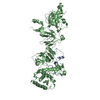

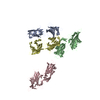
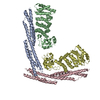

 PDBj
PDBj













